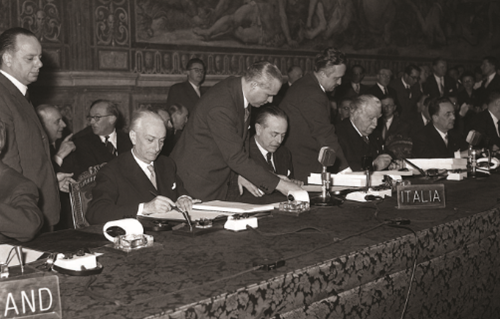The "Treaties of Rome" were signed in Rome on 25th March 1957. They are considered as the foundation acts of the European Community.
The first Treaty established the European Economic Community (EEC) while the second one established the European Atomic Energy Community, better known as EURATOM.

The Euratom Treaty was initially created in order to coordinate research programs of the Member States to promote a pacific use of nuclear energy. Nowadays, it provides its contribution to the sharing of knowledge, infrastructures and funding of nuclear energy.
The EEC Treaty brought together France, Germany, Italy and Benelux countries in a community whose objectives (according to Article 2) were to create a common market and ensure the transformation of the conditions of trade and manufacture in the Community.
Nevertheless, a further political aim was that of the contribution to the functional construction of a political Europe and a step towards a closer unification of Europe. In the preamble, the signatories of the Treaty declared "to be determined to lay the foundations of an ever closer union among the peoples of Europe".
The first articles of the Treaty (which consists of 240 articles) established the primary mission of the Community, i.e. the creation of a common market; they hence specified the measures and timetables to be undertaken to achieve this objective.
The EEC Treaty also abolished custom duties between the Member States. It established a common external tariff that replaced the former national tariffs. This tariff was considered as a sort of external border for third Countries’ products. Furthermore, the Treaty provided for the development of common policies as for example the agricultural policy (the CAP), the trade policy and the transport policy.
With the aim of improving job opportunities for workers and to raise their standard of living, the Treaty also provided for a European Social Fund. Moreover, a European Investment Bank was established in order facilitate the Community’s economic expansion through new financial resources.
As far as the institutional side is concerned, the Treaties introduced further novelties, as for example the creation of a High Authority (later European Commission), a Council of Ministers (later Council of the EU), a Parliamentary Assembly (later European Parliament). This institutional balance was based on a triangle of institutions, all three called upon to work together, the Commission preparing the proposals, the Council issuing the regulations and the Parliament playing an advisory role.
The Treaty also provided for the creation of a Court of Justice.
